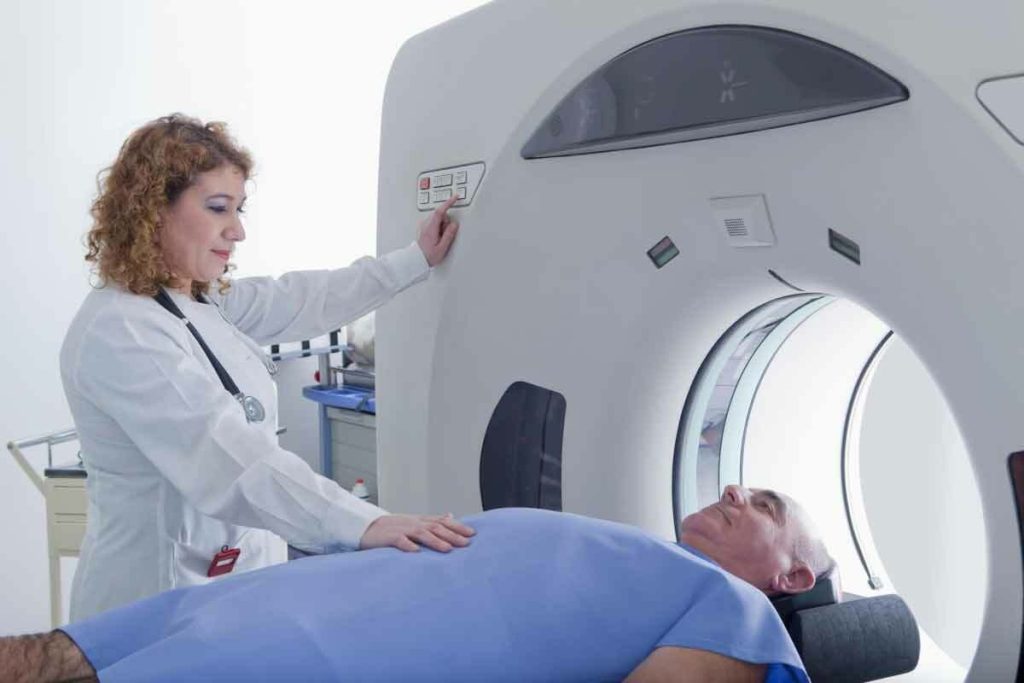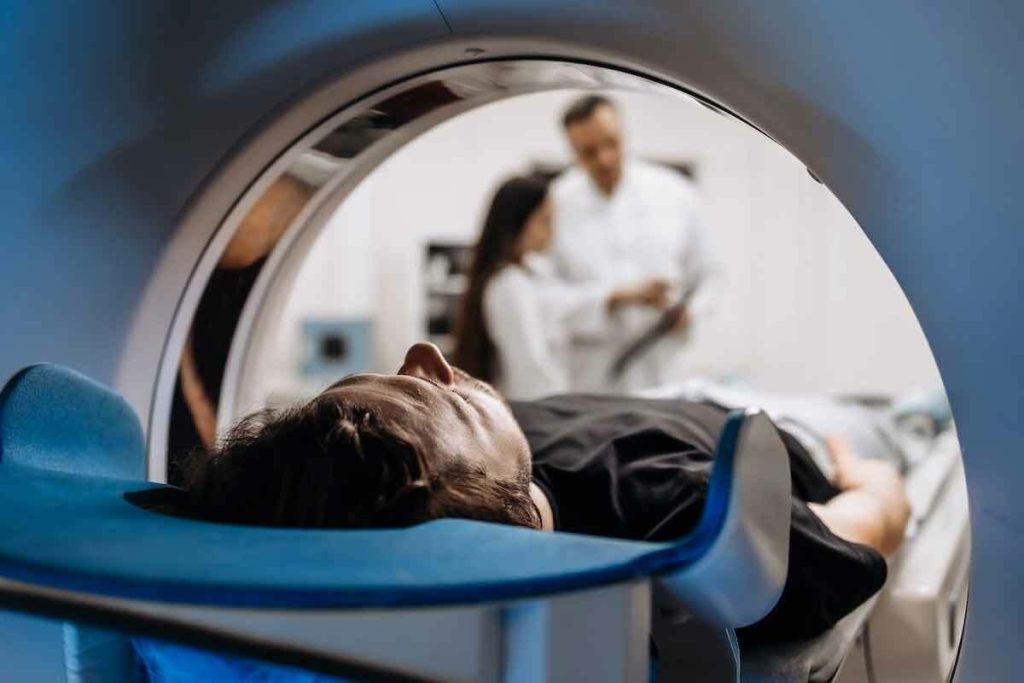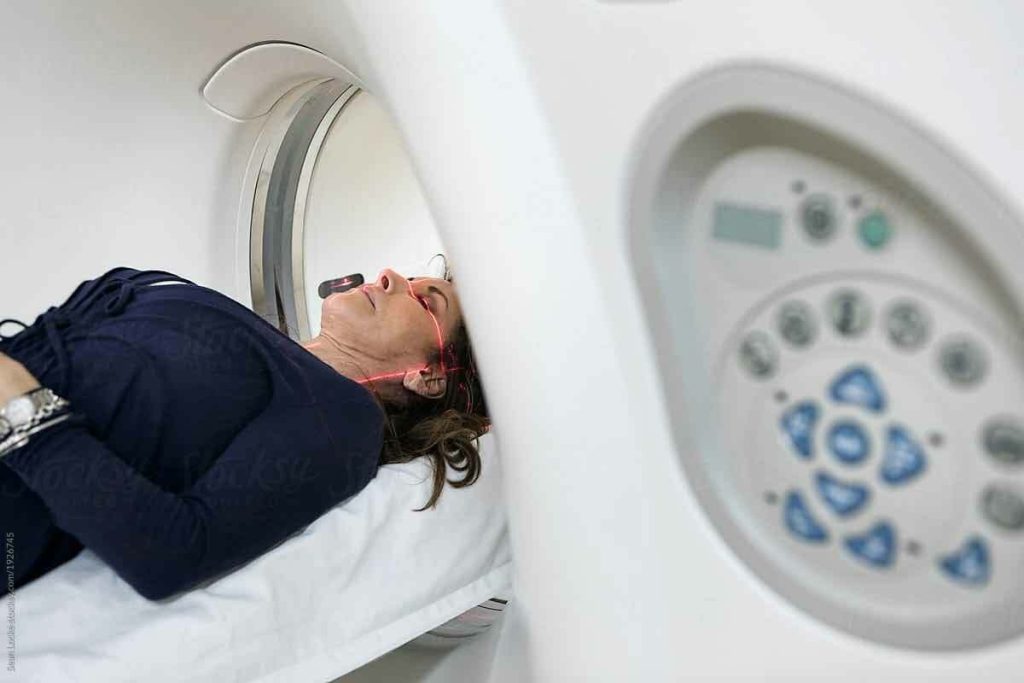
At Liv Hospital, we use the latest imaging tech for accurate diagnoses and treatment plans. A CT scan of throat, also known as a neck CT or cat scan of the neck, helps find issues like tumors, infections, or structural problems in the throat and neck.
A CT scan uses X-rays to create detailed pictures of the body’s inside. You’ll lie on a table attached to the CT scanner, a big doughnut-shaped machine. Our expert team will help you through it, making sure you’re comfortable and safe.

It’s important for both patients and doctors to know about CT scans for throat issues. A CT scan of the throat uses X-rays to show detailed pictures of the throat area.
A CT scan of the throat is a safe way to see inside the throat. It shows the larynx, pharynx, and other nearby parts. It uses X-rays and computer tech to make clear images for doctors to look at.
The scan happens when you lie on a table that moves into a CT scanner. The scanner moves around you, taking pictures from all sides. Then, it makes detailed pictures of your throat.
CT scans of the neck are compared to MRI and ultrasound. MRI shows soft tissues well without using radiation. But, CT scans are quicker and easier to get. Ultrasound is good for the surface but not as detailed for deeper areas.
| Imaging Modality | Radiation Exposure | Soft Tissue Detail | Speed and Availability |
| CT Scan | Yes | Excellent | Fast and widely available |
| MRI | No | Excellent | Slower and less available |
| Ultrasound | No | Good for superficial structures | Fast and widely available |
CT scans are great for finding tumors, infections, and other neck problems. The right imaging choice depends on the situation, the patient, and what the doctor thinks might be wrong.

A CT scan of the throat is a detailed diagnostic tool. Knowing about it can help you prepare better. It’s important to understand how it works and what to expect.
A CT scan of the neck can spot problems like tumors and abscesses. It’s key for finding out what’s wrong and how to treat it.
CT scans use X-rays, but the dose is usually worth it for the benefits. New CT scanners aim to use less radiation while keeping image quality high.
A CT scan of the throat usually takes 15 to 40 minutes. The actual scan time is often under 20 minutes. The whole visit, including getting ready, is usually less than an hour.
CT scans can be done with or without contrast. The contrast agent makes some areas stand out more. The choice depends on what the doctor is looking for.
| Procedure Aspect | With Contrast | Without Contrast |
| Diagnostic Use | Enhanced visualization of blood vessels and certain lesions | Suitable for detecting calcifications and some structural abnormalities |
| Preparation | May require fasting or specific preparation before the scan | Generally, no special preparation is required |
| Potential Side Effects | Risk of allergic reactions to the contrast agent | No risk of allergic reactions |
Knowing these facts about CT scans of the throat can make you feel more ready. It helps you understand what to expect. This way, you can make better choices about your health.
Neck CT scans are very useful. They can find many health issues and help doctors plan treatments. These scans show both bones and soft tissues clearly.
These scans are key in finding tumors and growths in the neck. They show how big, where, and how far these growths are. This info is key for treatment plans.
Some tumors and growths that can be found include:
CT scans can also spot infections and inflammatory issues. They give detailed pictures to help figure out what’s going on.
Examples of these issues include:
A CT scan with contrast is great for looking at structural problems and injuries. It checks bones and soft tissues for damage.
Some issues it can find are:
Before a neck CT scan, you might need to fast for a few hours. You should also avoid some medicines unless told to do so. CT scans can show bones and soft tissues, like muscles and organs, better than X-rays.
| Condition | Description | Diagnostic Capability of CT Scan |
| Tumors and Abnormal Growths | Includes thyroid nodules, lymph node abnormalities, and salivary gland tumors | High-resolution images help identify size, location, and extent |
| Infections and Inflammatory Disorders | Includes abscesses, cellulitis, and inflammatory conditions like thyroiditis | Differentiates between various conditions with detailed imaging |
| Structural Abnormalities and Trauma | Includes fractures, dislocations, and soft tissue injuries | Assesses injuries to bones and soft tissues with high accuracy |
It’s important to know about the different CT scans for the neck. This helps both patients and doctors. The right scan depends on the health issue and how detailed the image needs to be.
A standard CT scan without contrast shows the neck’s structures. It’s great for finding things like bone problems or calcifications.
Benefits: It’s fast, doesn’t hurt, and doesn’t need contrast. This makes it safer for people with allergies or kidney issues.
A CT scan with contrast uses a special dye to make blood vessels and organs clearer. It’s best for spotting tumors, infections, or blood vessel diseases in the neck.
Benefits: The dye makes soft tissues easier to see. This helps doctors make more accurate diagnoses.
Doctors say using dye is good for clear images but can be risky for some. This might lead to choosing other imaging methods.
“Contrast agents are frequently used (IV or oral), specially for a CT scan with contrast of the neck, to improve diagnostic accuracy.”
| Type of CT Scan | Use of Contrast | Primary Use |
| Standard CT | No | Bone abnormalities, calcifications |
| CT with Contrast | Yes | Tumors, infections, vascular diseases |
In conclusion, picking between a standard CT scan and one with contrast depends on what’s needed. Both offer important insights into the neck’s health.
Getting ready for a CT scan of the throat is easy. Just follow a few steps to make sure everything goes well. Being prepared can really help your experience.
Tell your doctor about all the medicines you take before your CT scan of the neck. This includes any prescription drugs, over-the-counter meds, and supplements. Some medicines might need to be changed or stopped before the scan. Your doctor will tell you what to do based on your medicines.
If you’re having a ct scan neck contrast, your doctor might have special rules for your medicines and what you can eat or drink. It’s very important to follow these instructions to avoid any problems.
On the day of your neck with contrast ct scan or a non-contrast CT scan, wear comfy clothes that are easy to take off. You’ll need to change into a gown. Try to avoid wearing anything with metal, like jewelry or clothes with metal parts, as they can mess with the scan.
Before the scan, you’ll need to remove any metal objects. This includes:
You might also need to not eat or drink for a few hours before the scan, if it’s a ct scan neck contrast. This helps the contrast material work better.
By following these tips, you’ll be ready for your CT scan of the throat. This ensures the scan goes smoothly and the images are clear for accurate diagnosis.
Contrast agents are key in CT scans of the throat. They help make certain areas or structures more visible. This makes it easier to see the throat area clearly.
In CT scans with contrast of the neck, iodine-based agents are common. These agents highlight blood vessels and other neck structures. They are given through an IV to improve scan visibility.
Medical experts say contrast agents have changed diagnostic imaging. They help doctors make more accurate diagnoses. The contrast type depends on the scan’s needs and the patient’s history.
While safe, contrast agents can cause side effects or allergic reactions. Symptoms include itching, wheezing, or feeling sick. Rarely, severe reactions can happen. Always tell your doctor about allergies before a ct neck scan with contrast.
It’s important to inform the department about kidney disease or a transplant before a scan. The contrast is removed through urine. Kidney issues can affect how it’s processed.
Knowing about contrast agents and their side effects helps prepare for a ct scan with contrast of the neck. It ensures a smooth scanning experience.
Getting ready for a CT scan of the throat means knowing what to expect. We’ll show you the steps, from when you arrive to when the scan is done.
When you get there, you’ll go to the CT scan room. Our team will help you get ready. They’ll ask you to take off any jewelry, glasses, or things that might get in the way.
If you need a CT scan with contrast, they’ll put in an IV line. This is to give you the contrast material.
They’ll explain everything to you, answer your questions, and make sure you’re comfortable on the table.
You’ll lie on a couch that slides into the scanner. The CT technologist will make sure you’re in the right spot. They’ll make sure the area to be scanned is in the middle.
The scanner sends X-rays through your body. Each time it moves, it takes a picture of a thin slice of your body.
Once you’re set up, the CT technologist will leave and start the scan from another room. The scanner will move around you, taking pictures of your neck. You might need to hold your breath for a bit.
The scan itself is fast, usually just a few minutes. But getting ready and settled in can take about 15-30 minutes.
“The CT scan is a painless, non-invasive procedure that provides valuable diagnostic information,” says a radiologist with over 10 years of experience.
| Step | Description | Duration |
| Pre-scan preparation | Removal of interfering items, IV line for contrast | 5-10 minutes |
| Positioning | Correct placement on the CT scan table | 2-5 minutes |
| Scanning | Actual CT scan procedure | 2-5 minutes |
Knowing how long a neck CT scan takes is important. It helps patients plan their visit better. We know time is precious, and knowing what to expect can reduce stress.
There are two main things to think about: the scan itself and the whole visit. Let’s look at what you can expect.
The actual CT scan of the neck is usually fast, lasting 5 to 10 minutes. This time can change a bit, depending on the scan’s details, like if contrast is used.
Even though the scan is quick, the whole visit will take longer. You should plan to be there for 15 to 30 minutes. This includes:
If you’re getting a CT scan with contrast, you might need more time. We’ll help you through this, making sure you’re comfortable and informed.
Understanding your neck CT scan’s duration helps you plan your day better. It also reduces anxiety about the unknown. We aim to make your experience as smooth and comfortable as possible.
Before a CT scan with contrast for your neck, it’s good to know what to expect. This test uses contrast to show the neck’s structures and vessels. Knowing the steps can make you feel less anxious and more comfortable.
Getting the contrast agent is a part of the CT scan. You might feel a flushing sensation or an odd taste in your mouth. These feelings are short-lived and go away quickly.
The contrast goes into your arm through an IV line. You might feel a pinch from the needle, but the contrast itself doesn’t hurt. Some people feel warmth or coldness as it spreads through their body.
The technologist will help you through the CT scan. It’s important to talk about any discomfort or worries you have. They can change the scan to make you more comfortable.
Before starting, you’ll take off any jewelry or metal. Then, you’ll lie on a table that moves into the CT scanner. The technologist will tell you when to hold your breath or stay very quiet.
| Aspect | Description |
| Contrast Administration | May cause flushing sensation or odd taste |
| Communication | Technologist will guide you through the process |
| Preparation | Remove jewelry and metal objects |
After your CT scan, you can usually go back to your normal activities right away. Understanding your results and what comes next happens after the scan.
Right after the CT scan, you might need to wait a bit for the radiologist to check the images. Usually, you can leave the facility once the scan is done. If you got contrast material, drinking lots of water is recommended to clear it from your system.
A radiologist will look at your CT scan images and send a detailed report to your doctor. It can take a few hours to a couple of days to get your results, depending on how urgent it is and the facility’s schedule.
Your doctor will talk to you about the results. They’ll explain what they found and what you might need to do next. This could include more tests, treatment, or just keeping an eye on your condition.
The cost of a neck CT scan can differ a lot in the United States. Without contrast, it’s usually between $800 and $1,500. With contrast, it can cost between $1,000 and $2,500 or more.
| Procedure | Average Cost | Range |
| CT Scan of Neck without Contrast | $1,000 | $800 – $1,500 |
| CT Scan of Neck with Contrast | $1,800 | $1,000 – $2,500 |
Most health insurance plans cover CT scans when they’re needed for medical reasons. But, it’s important to check with your insurance to know what’s covered and if you need preapproval. Some plans might need a referral or preapproval before you can get the scan.
Knowing your insurance coverage can help avoid surprise medical bills. Make sure to ask about any costs you might have to pay, like deductibles, copays, or coinsurance, for your CT scan.
Knowing about CT scans of the throat and neck is key for patients. We’ve looked at what CT scans can do, how to prepare, and what happens during the scan. A CT scan of the neck gives detailed pictures. These help doctors find and treat many issues, like tumors and infections.
Learning what to expect from a CT scan can help patients feel less nervous. It makes the experience easier. Contrast agents make the images clearer, helping doctors make better diagnoses.
CT scans are a big help in healthcare. We hope this info has shown how important and useful a CT scan of the throat is for medical care.
A CT scan of the throat is a test that uses X-rays and computer tech. It makes detailed images of the throat and nearby areas.
A neck CT scan takes 5 to 10 minutes to scan. But, getting ready and processing takes longer. So, it can take 30 minutes to an hour.
A CT scan with contrast uses a special dye to show certain areas. A non-contrast scan doesn’t use dye.
Contrast agents can cause mild side effects like nausea or itching. But, serious reactions like anaphylaxis are rare. Always tell your doctor about allergies or kidney problems.
To get ready for a CT scan, remove jewelry and glasses. Wear loose clothes. Your doctor might tell you about medication and fasting.
Neck CT scans can find tumors, infections, and structural issues. They help diagnose many conditions.
In the U.S., a neck CT scan costs between $500 and $1,500. Prices vary by location and insurance.
Insurance for CT scans varies. Always check with your provider to see what’s covered and if you need approval.
After a CT scan, you can go back to normal activities right away. The images are reviewed by a radiologist. Your doctor will talk to you about the results and what to do next.
Tell your doctor about any health issues or allergies before a CT scan. Some conditions might need special care or other tests.
Subscribe to our e-newsletter to stay informed about the latest innovations in the world of health and exclusive offers!
WhatsApp us